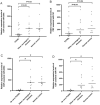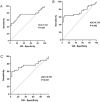Exosomal miR-200c and miR-141 as cerebrospinal fluid biopsy biomarkers for the response to chemotherapy in primary central nervous system lymphoma
- PMID: 37971595
- PMCID: PMC10654293
- DOI: 10.1007/s12672-023-00812-1
Exosomal miR-200c and miR-141 as cerebrospinal fluid biopsy biomarkers for the response to chemotherapy in primary central nervous system lymphoma
Abstract
Background: To improve early diagnosis and chemotherapy efficacy monitoring in primary central nervous system lymphoma (PCNSL), cerebrospinal fluid (CSF) exosomal microRNA (miRNA) studies were performed.
Method: Small RNA sequencing was performed to identify candidate exosomal miRNAs as CSF biopsy biomarkers from two patients with de novo PCNSL and two patients in remission after chemotherapy. miR-200c and miR-141 expression in CSF exosomes was further validated using relative quantitative real-time polymerase chain reaction in patients with PCNSL (n = 20), patients with other neurological diseases (n = 10), and normal subjects (n = 10). Receiver operating characteristic (ROC) curve analyses of miR-200c and miR-141 in the diagnosis and prediction of chemotherapy efficacy in PCNSL were performed in patients treated with methotrexate. Additionally, bioinformatics tools were utilized to predict the potential targets of miR-200c and miR-141.
Results: Exosomal miR-200c and miR-141 levels in CSF from patients with PCNSL were significantly lower than those in control subjects. Importantly, miR-200c and miR-141 were upregulated in patients with PCNSL after chemotherapy (P = 0.002). There was a significant correlation between the levels of miR-141 and IL-10 in CSF (P = 0.04). The combination of miR-200c and miR-141 yielded an area under the ROC curve of 0.761 for distinguishing PCNSL with sensitivity and specificity of 60.0% and 96.7%, respectively. The potential target genes of miR-200c and miR-141 in PCNSL included ATP1B3, DYNC1H1, MATR3, NUCKS1, ZNF638, NUDT4, RCN2, GNPDA1, ZBTB38, and DOLK.
Conclusion: Collectively, miR-200c and miR-141 are likely to be upregulated in CSF exosomes after chemotherapy in patients with PCNSL, highlighting their potential as reliable liquid biopsy biomarkers for PCNSL diagnosis and chemotherapy efficacy monitoring.
Keywords: Cerebrospinal fluid; Chemotherapy; Exosome; Primary central nervous system lymphoma; microRNA.
© 2023. The Author(s).
Conflict of interest statement
The authors declare that they have no conflicts of interest.
Figures






References
-
- Dandachi D, Ostrom QT, Chong I, Serpa JA, Giordano TP, Kruchko C, et al. Primary central nervous system lymphoma in patients with and without HIV infection: a multicenter study and comparison with U.S national data. Cancer Causes Control. 2019;30(5):477–488. doi: 10.1007/s10552-019-01144-8. - DOI - PubMed
Grants and funding
LinkOut - more resources
Full Text Sources
Miscellaneous
